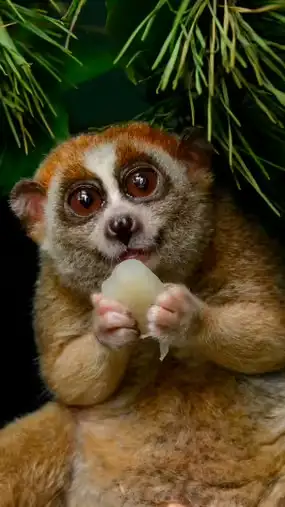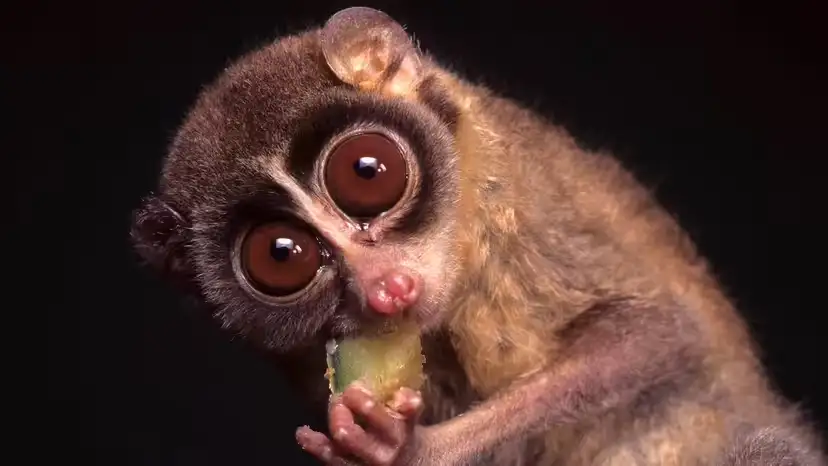Despite their irresistibly round eyes, button noses, and plush fur, slow lorises (genus Nycticebus) are far from the harmless, cuddly creatures the internet makes them out to be. In reality, they are one of the few mammals on Earth with a truly toxic bite, and their gentle appearance masks a complex, highly specialized, and surprisingly fierce primate.
This detailed guide—based on scientific literature, expert interviews, and conservation data—will help you understand what slow lorises really are: extraordinary animals adapted for nocturnal life, family-oriented primates, and sadly, victims of illegal wildlife trade.

Slow lorises are small nocturnal primates native to Southeast Asia. Their appearance—
a round head,
huge forward-facing eyes,
tiny ears,
and a short, stout body
—has led some early naturalists to describe them as “having the face of a bear, the hands of a monkey, and moving like a sloth.”
The name “loris” is thought to come from the old Dutch word loeris, meaning “clown,” likely referring to their bold facial patterns that resemble a mask.
| Feature | Description |
|---|---|
| Eyes | Oversized with a reflective membrane (tapetum lucidum) for night vision |
| Tail | Extremely short, hidden under dense fur |
| Weight | Ranges from 265 g (Bornean slow loris) to 2,100 g (Bengal slow loris) |
| Length | 18–38 cm depending on species |
These adaptations allow lorises to move silently through dense forests, hunting insects with remarkable precision.

One of the most surprising facts about slow lorises is their venom—a rare trait among mammals.
They raise their arms above their head.
Special brachial glands on their upper arms secrete a toxic substance.
The loris licks this secretion, mixing it with saliva.
The venom pools into grooves along their sharp canine teeth.
Tissue necrosis
Severe pain
Dangerous allergic reactions
Potentially fatal consequences if untreated
This venom evolved primarily as a defense mechanism against predators—and unfortunately, against humans attempting to capture or handle them.
Slow lorises inhabit Southeast Asia, including:
Vietnam
Laos
Eastern Cambodia
Yunnan Province in China
Thailand, Malaysia, Indonesia (depending on species)
They prefer:
bamboo groves
primary rainforest
hardwood forests
During the day, they curl up tightly inside tree hollows or dense vegetation. At night, they emerge to forage using a keen sense of smell.
Their diet includes:
insects
gum and tree sap
nectar
small vertebrates
fruits
dew collected from leaves
Their flexible diet allows them to survive in varying environments, though habitat loss remains a major threat.

To better understand loris behavior, researchers from institutions like the Duke Lemur Center and Oxford Brookes University have spent decades observing them.
Although often described as solitary, wild lorises have a subtle social life:
families sometimes share the same sleeping site
grooming is a common bonding behavior
adult males and females may remain together while raising young
dominance hierarchy is minimal or absent
Caregivers who worked with lorises in captivity report that individuals range from:
extremely shy
cautious and slow to trust
highly curious and interactive
socially bold
These personality differences are typical of many primates and highlight their cognitive complexity.
According to primatologist Dr. Anna Nekaris, who has studied wild lorises for over 20 years:
Slow lorises can mate year-round.
Offspring often remain with parents for up to three years.
Wild family groups may include up to six members.
In captivity, bonding can be less predictable:
some breeding pairs are incompatible
mothers may “evict” offspring at different ages
young lorises must be carefully managed to avoid injuries
Breeding programs follow species survival plans to maintain genetic diversity and avoid inbreeding.
Every species of slow loris is now listed as Vulnerable or Endangered by the IUCN.
Deforestation
Agricultural expansion
Fragmentation of forest habitat
In places like Java, slow loris habitat has shrunk by up to 90%.
Slow lorises have become viral sensations online because of videos showing people “tickling” them or keeping them as pets. However:
Lorises in the pet trade often have their teeth cruelly removed.
The “hands-up” pose is not enjoyment—it is a defense posture signaling fear.
Removing them from the wild devastates wild populations.
In some regions, lorises are killed for perceived medicinal uses—a practice unsupported by science.
Universities and conservation groups are working on innovative strategies to protect lorises.
For example, the Nocturnal Primate Research Group in the UK is installing “loris bridges”—overhead pathways created from irrigation tubing—to reconnect fragmented treetops in Java. These bridges help lorises move safely across their natural range.
Other initiatives include:
rescue and rehabilitation centers
anti-poaching patrols
habitat restoration programs
community education in villages near loris habitats
Despite their cute appearance, slow lorises are not suitable pets.
they are venomous
highly sensitive to stress and bright light
require a complex forest environment
nocturnal behavior does not match human lifestyle
removal from the wild is devastating to conservation efforts
Reputable wildlife centers strongly warn against buying or interacting with lorises for entertainment purposes.
Slow lorises are remarkable creatures—venomous, gentle, intelligent, and deeply tied to the forests they inhabit. Their survival depends not only on scientific research but also on public understanding. The biggest threat to their existence is the misconception that they are cute toys or exotic pets.
True appreciation means respecting their wild nature and supporting conservation efforts that ensure future generations can admire them—safely and ethically.
animal tags: Slow Loris
We created this article in conjunction with AI technology, then made sure it was fact-checked and edited by a Animals Top editor.